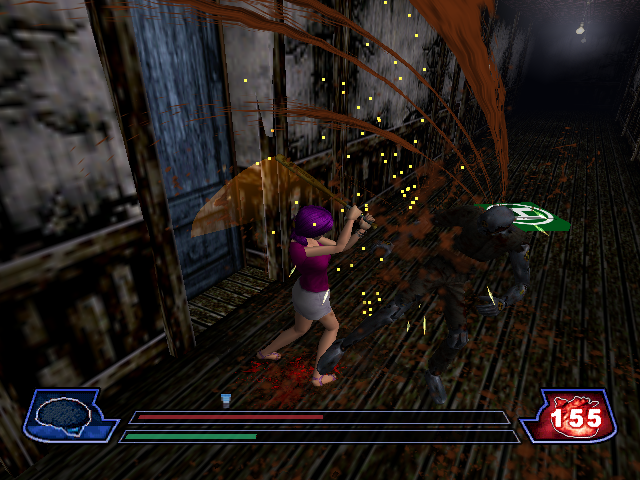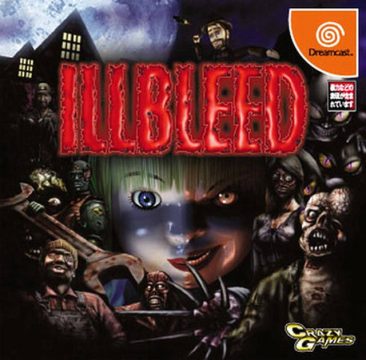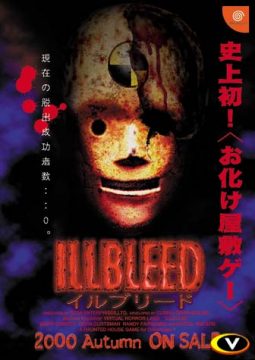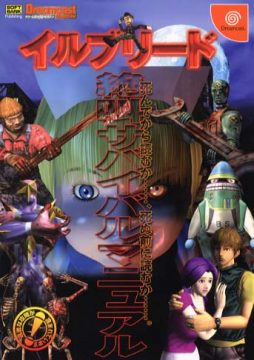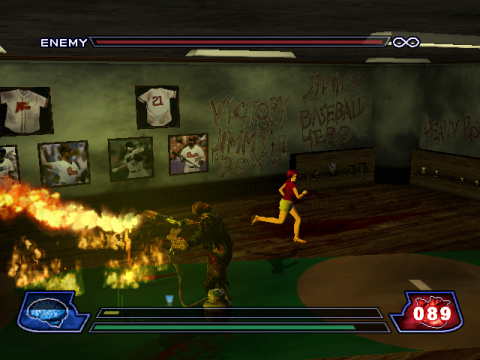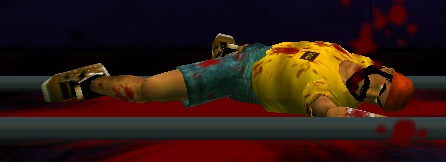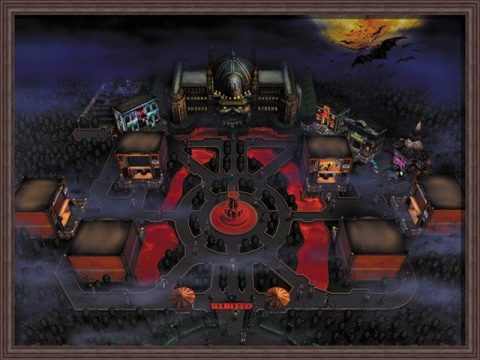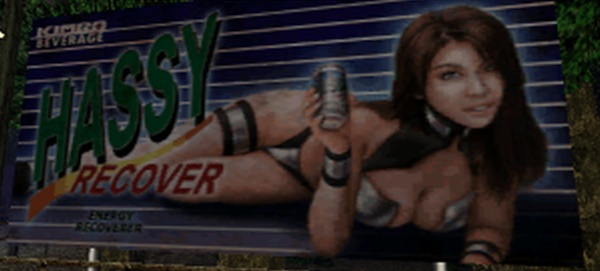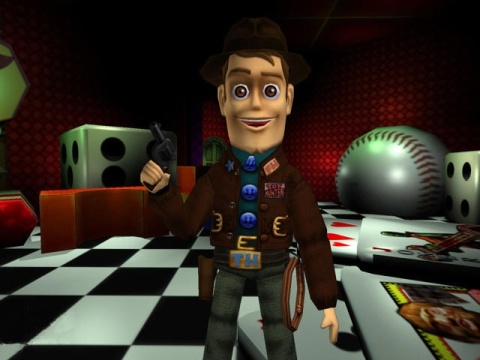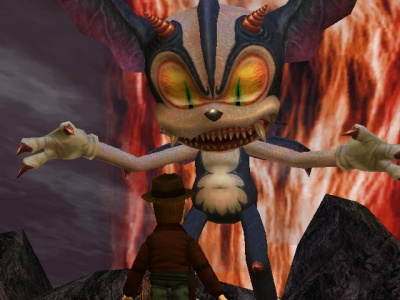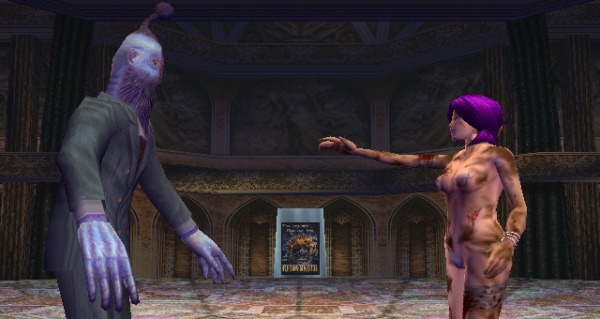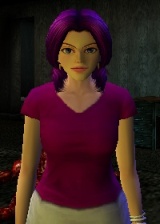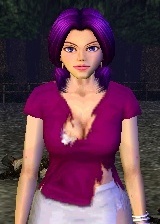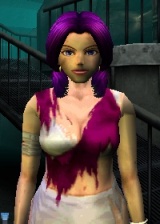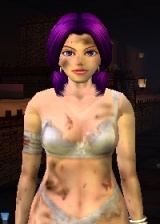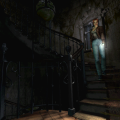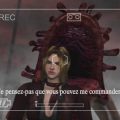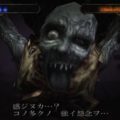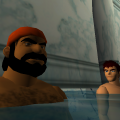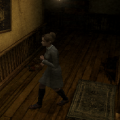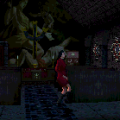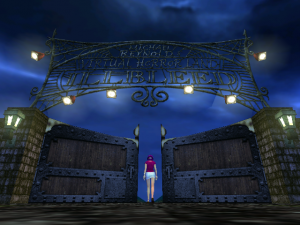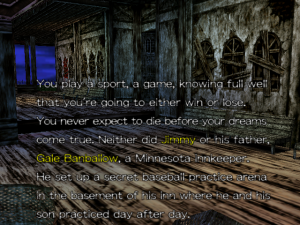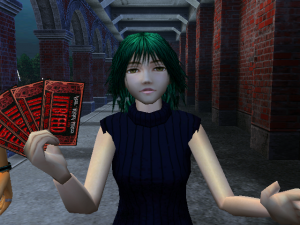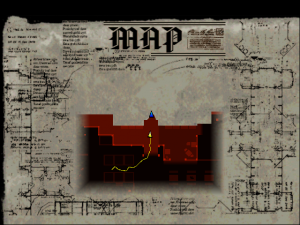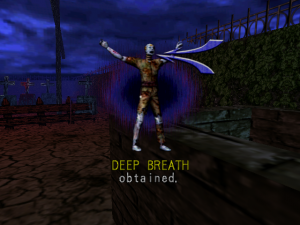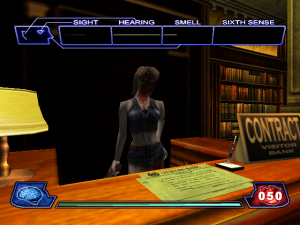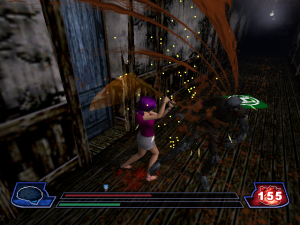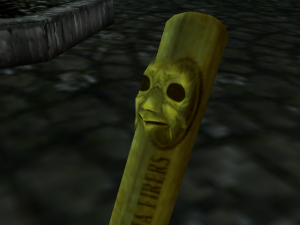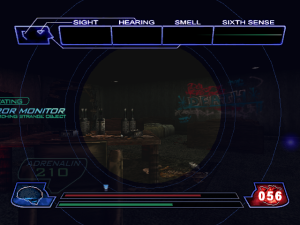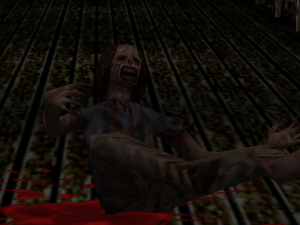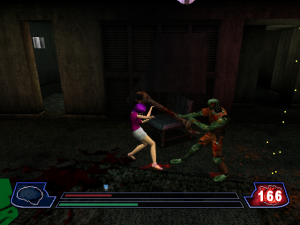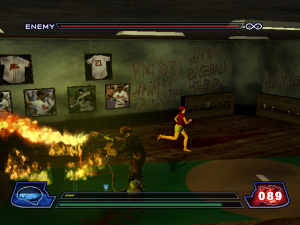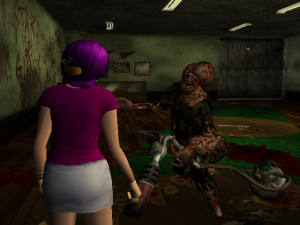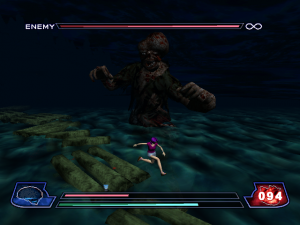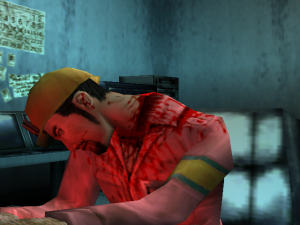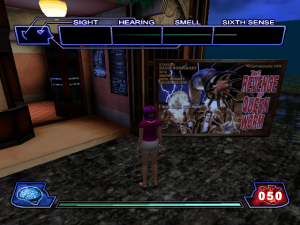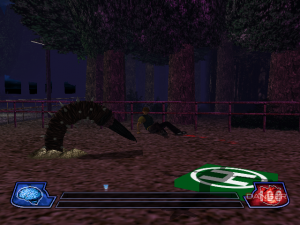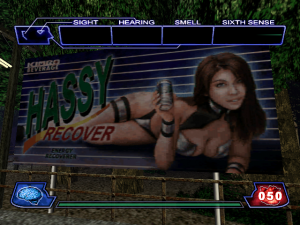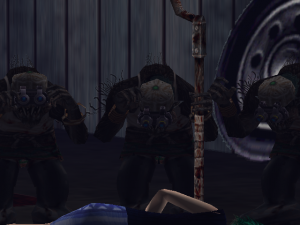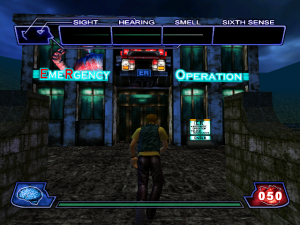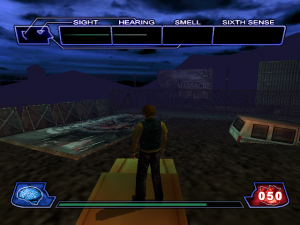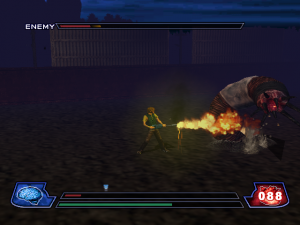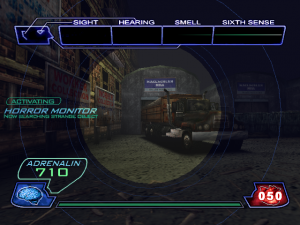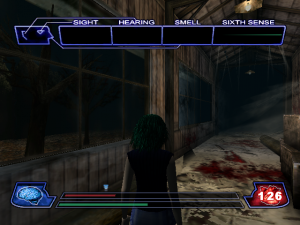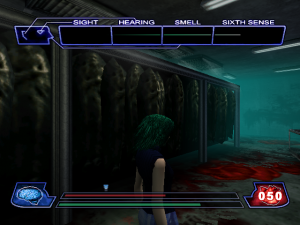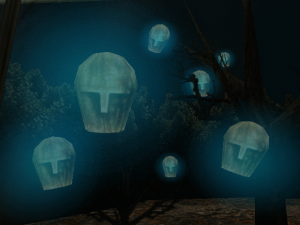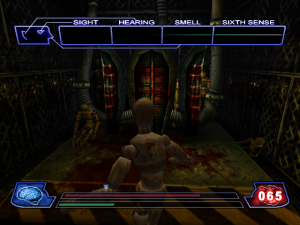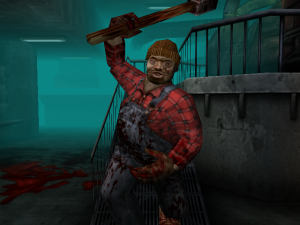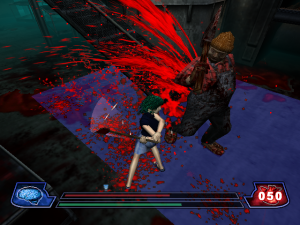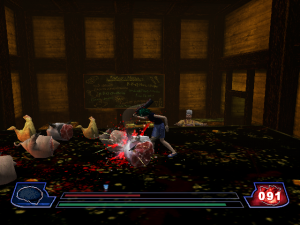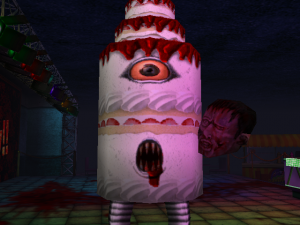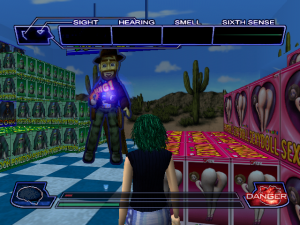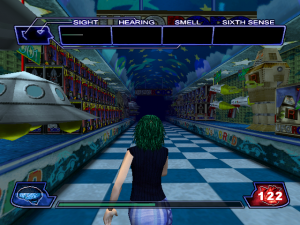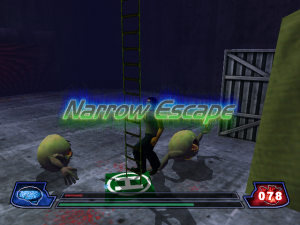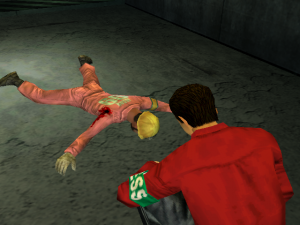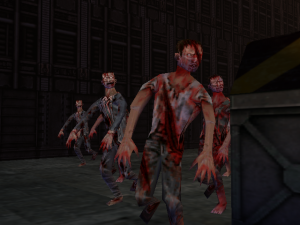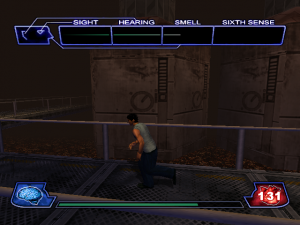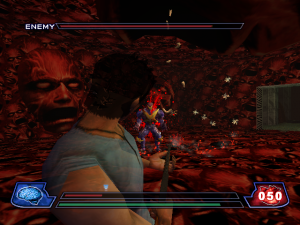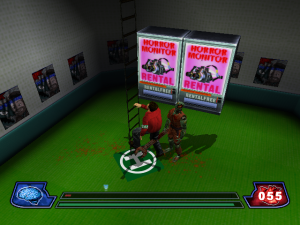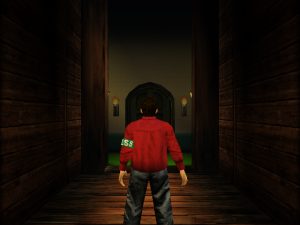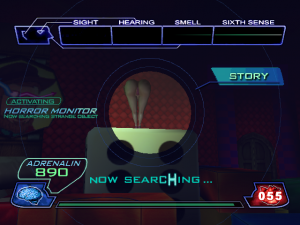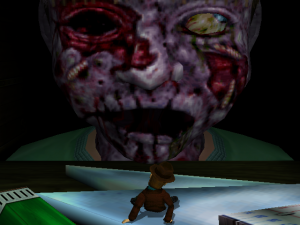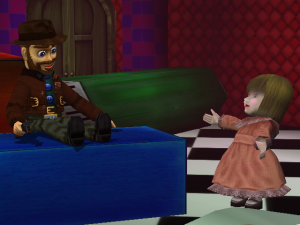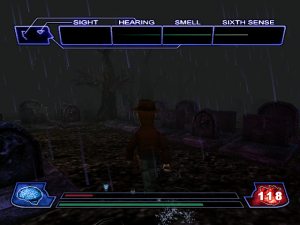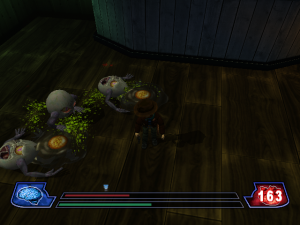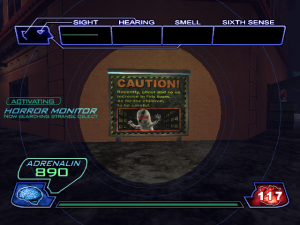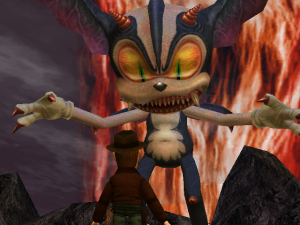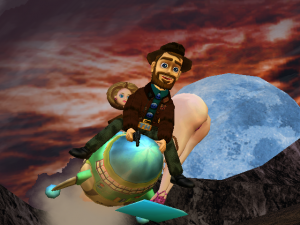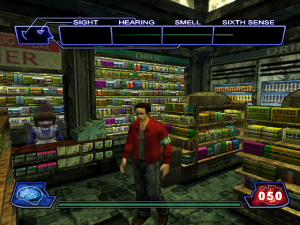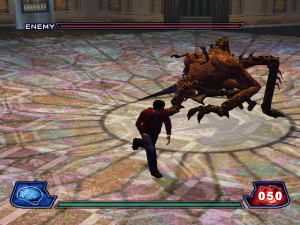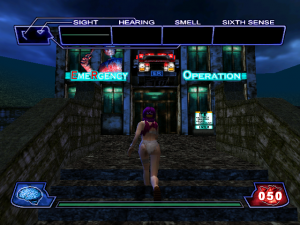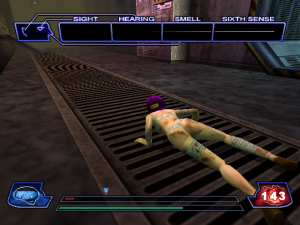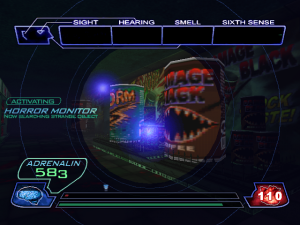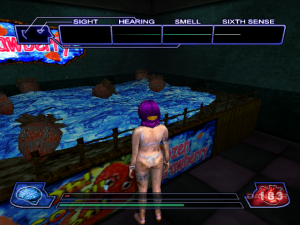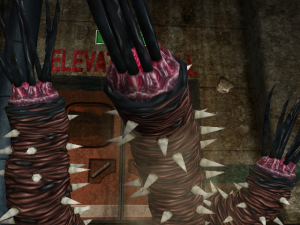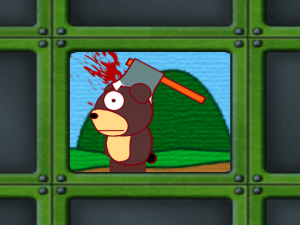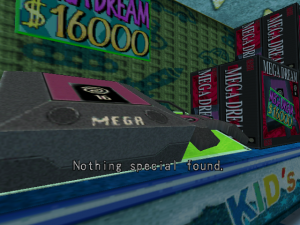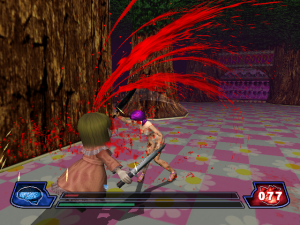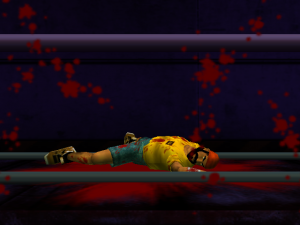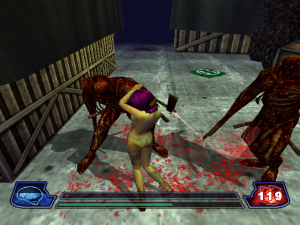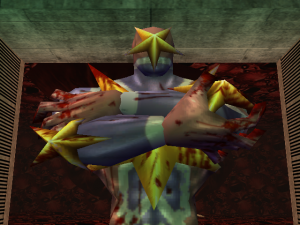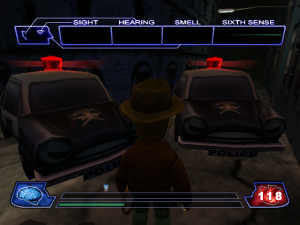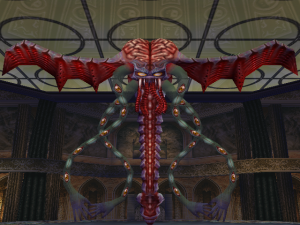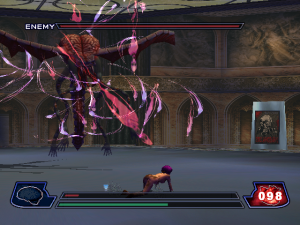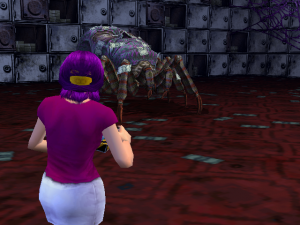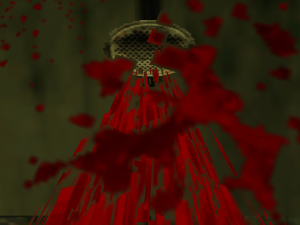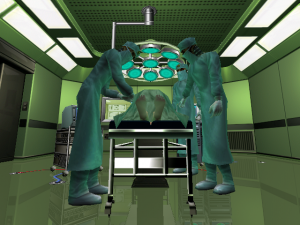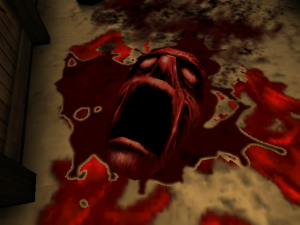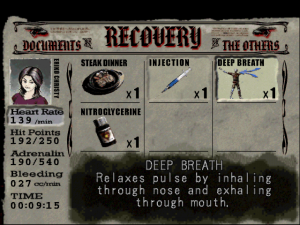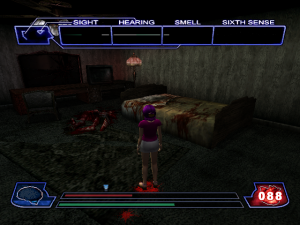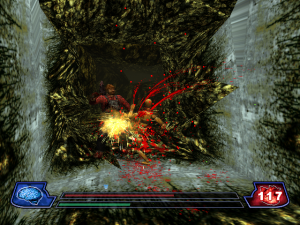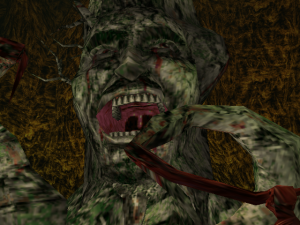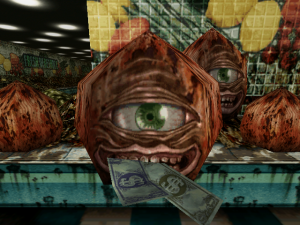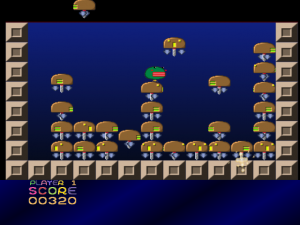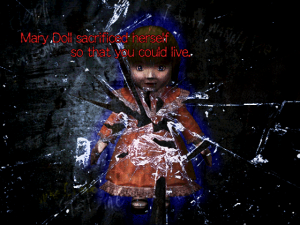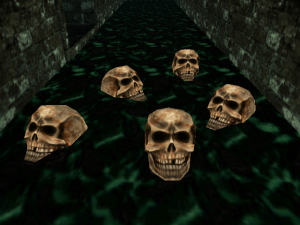It isn’t much what Crazy Games left the world during their short existence – two titles for Sega’s ill-fated final home console, and contributions to the obscure Hitmaker arcade lightgun shooter The Maze of the Kings – but it came from a pedigree worth bragging about. Originally named Climax Graphics, Shinya Nishigaki’s company was an off-shoot of Climax Entertainment, famous for Landstalker and its successors, founded by former Chunsoft employees and Dragon Quest veterans. Climax Graphic’s first product had been the early Dreamcast horror game Blue Stinger. It could garner some mild success thanks to a lack of alternatives on the system – Resident Evil: Code Veronica was still far on the horizon – but ultimately it was showered with lukewarm verdicts, both due to technical issues (mostly the bad camera) and because in the end it looked and felt like a generic genre piece. Apparently Climax Graphics took that last criticism to heart, as their next project was to be everything but generic.
Illbleed was officially announced on March 24, 2000, almost exactly a year after Blue Stinger‘s Japanese release, a trailer full of campy craziness and narrated by the inimitable John St. John in his Duke Nukem voice followed at E3 in May. Unfortunately, his voice was gone the next year, when the game neared release.
Illbleed is not only the title of the game, but also the name of the plot’s location – a weird kind of horror cinema/theme park, created by the mysterious Michael Reynolds. The funny thing about this park: It actually kills people. But there’s a $1000,000,000 prize for those brave and able enough to make it through all its stations alive. The Local School’s Horror Movie Research Club (every school should have one) decide they can take on the challenge. But when their leader Eriko arrives late at the park, all her friends have already been captured, so she has to go in alone and try to save her friends…
Characters

Eriko Christy
She is the head of the Horror Movie Research Club. Ever since her father made her watch all existing horror movies from early childhood, she has lost her sense of fear. No one knows more about horror movies than her. She also starred in Killerman VII – Killerman Goes to Japan, whose eponymous villain is also an attraction in Illbleed.

Kevin Kentsman
Kevin is presented as a typical ’90s cool kid, but he’s also a major horror film nerd, his favourite series being the Hamar(sic!) Dracula films. He hate modern slasher flicks, though.
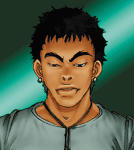
Randy Fairbanks
As the obligatory “jock” type character (though – of course – also a horror movie nerd), Randy is a bit dense. It is actually possible to forget retrieving his brain when rescuing him, but it doesn’t seem to be too much of a loss. In turn he can handle himself in a fight better than the others.

Michel Water
She holds an award by the Spiritual Capacity Association, whatever that’s supposed to mean. She acts as the group’s expert on ghosts and spirits, and the most able to detect paranormal activity.
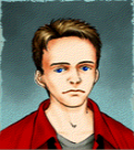
Jorg S. Baker
Not a member of the Horror Movie Research Club, but a reporter investigating mysterious murders on the park’s staff members. He eventually ends up grabbed by Zombies before he can solve the case and has to be rescued as well. He is named after Jörg S. Tittel, who did publicity work for Crazy Games and as it appears also lent his voice to the character.
At first look, Illbleed seems like a regular action-adventure with rather awkward controls. It’s not the infamous tank-scheme embraced by many ’90s horror games, but Eriko can’t simply turn and walk into another direction, either. Every turn goes together with another step forward, kinda like Ryu in Shenmue. It’s obvious the developers took the critique to the camera in Blue Stinger to heart, as there are four different modes with different angles. The Automatic modes are pretty straight-forward over-the-shoulder perspectives that work out quite well with a few exceptions where they can get stuck near a corner; the other two, called Semi-Automatic, are pretty much useless, as they tend to sway above the character’s head, where one can see next to nothing of the surroundings. The left trigger is there to put the camera back straight behind like in The Legend of Zelda: Ocarina of Time, but the Automatic modes produce better results no matter what.
After walking around a little in the first stage, at least manual-rejecting players will find themselves stumbling into traps they can’t do anything about over and over again. The HUD simulates the character’s senses in a line moving from left-to right, that deflects stronger the nearer one gets to danger. But even when anticipating the attack, there’s no way to react. Not before finding the Horror Monitor, that is. This device can be found early in each stage by triggering all four senses at once, and vaguely resembles the Ghostbusters‘ Paragoggles. Now you can use it to look around in first-person and “mark” danger spots, effectively disarming the trap. The senses come still into play though, as there are many fake spots, and only finding actual traps recharges the adrenaline needed for further detection. Sight, Hearing and Smell all effectively mean the same thing: There’s a trap coming up. The difference is merely there to add flavor and to diffuse the display to add more challenge. The fourth sense (ironically named Sixth Sense), however, indicates that there’s either a hidden item nearby, or a fight coming up. Marking traps also means that you’re missing out on the shock effects, but other than the rest of the game, they’re not that inventive, anyway. About a third of them is just blood, gas, feces or some other goo spilling out somewhere; many others just the monster of the week popping up its head to scare or wound unwary adventurers.
Despite the ridiculous blood fountains and an astounding amount of semi-nudity, it’s all more akin the Scooby-Doo type of spooky fake-ghost story than any genuine horror. The story as a whole is very ambivalent as to how dangerous the whole adventure actually is. Even the degree of “reality” is not quite clear. Running around in the starting hub-world is accompanied by music they might have used just as well in an episode of The Addams Family or The Munsters, and each stage opens with a narration of a ghost story one hears at teenager campfire. The monsters are also all machines controlled by the park’s staff, but sometimes it’s implied that they’re out to kill visitors nonetheless. But there are also institutions for bringing them back to live, so maybe they’re not really killed? Either way, there’s only one thing that’s truly horrifying in Illbleed.
Did we say horrifying? Of course we meant to say there’s only one thing that’s truly horrible in Illbleed – and that’s the combat. No mater which camera angle was chosen before, here the game always switches to shitty cam and limits movement to a tiny area. But the not too responsive controls become the most serious problem now. It’s really hard to align oneself to hit the enemies, and all characters react painfully slowly to the attack button. Also all the melee weapons have ridiculously short range, and firearms aren’t available most of the time. Getting hit triggers an aggravatingly long stun animation. Attacks can be avoided with a dodge move, which always works when timed right – to hell with the actors’ actual location in 3D space – but increases heart rate with every step. Many enemies also seem to never go down, and many bosses really don’t until several encounters later (although it is indicated by an infinity sign next to their life bar). And when the enemy’s hideout hasn’t been marked with the horror monitor before, everyone but Eriko is so frightened they just crawl around helplessly at the beginning of the fight, making at least one or two guaranteed hits for the enemy in the smaller areas. When there are multiple enemies, it takes forever to get a decent shot at any of them. At least they can often be tricked into beating up each other. Fortunately, most fights can be escaped by waving your arms to call down a rescue helicopter (this works indoors!), but that means missing out on an adrenaline recharge, and the plot-related ones have to be fought out anyway.
Like the senses, the damage system is actually pretty cool and complex. Getting shocked just raises the heart rate, which only becomes a problem when the character is scared so much that they faint, making them helpless against enemies for a couple of seconds, or even die of fear. Jumping around or dodging a lot raises the heart rate as well. Then there’s a standard HP bar, which simply gets reduced from direct physical attacks. At low health the teenagers start limping like in most survival horror games that followed after Resident Evil. Finally, getting cut up raises a blood meter, which represents bleeding wounds. Both heart rate and blood meter can be reduced by just standing still for a while, but when someone gets wounded too badly, it starts to get worse simply from making wearisome movements, and starts to drain both HP and heart rate rapidly.
As long as Eriko is alone, dying from either cause means instant Game Over, but soon she gets to rescue her friends, which can effectively be used as extra lives, but everyone also has their own set of strengths and weaknesses. The latter can be straightened out by finding various artificial organs throughout the stages, but the operations to apply them are costly. Money is earned by completing stages, where all the health statuses and the amount of detected traps factor into the reward. It’s also possible – and often necessary – to buy healing items at the store before entering an attraction, but at least on the first playthrough it’s impossible to know which are really useful for the next stage. And stacking up resources for the long run isn’t a good idea, either, as all standard healing items are lost after completing a stage. There are also further gadgets that can only be found within – a sensor displays all hidden items on the stage map, and there’s a grenade that reveals all the danger points in a room, but the most important one is a “Shock Brace” that relieves the other kids from being useless idiots, crawling around the floor when monsters attack.
The real stars in Illbleed are the crazy stages – the parks attractions, all based on fictional trashy horror movies directed by Michael Reynolds. The first stage, “The Homerun of Death” is still the most conventional of the bunch, a crazy variation of the haunted house theme. It tells the story of former hotel owner Gale Banballow and his baseball prodigy son, who was tragically killed in a stupid teenage prank, just the day before his big game. Driven mad with grief, Banballow took to a flamethrower to kill teenagers from then on. Eriko has to make her way to the abandoned hotel, make acquaintance with a talking baseball bat, and defeat Banballow, who then turns into a gargantuan, house-eating monstrosity for some reasons. At the end, Illbleed also starts its play with layers of reality: Eriko finds the park employee who operates the monster with a remote control, and takes out her bat to brutally murder him. But it turns out he was a robot all along. Shocking!
“The Revenge of Queen Worm” is a homage to Tremors, thus giant sandworms are the main enemy here. They approach the player from underground and can only be avoided by staying on concrete ground. The boss is the largest of them all, Rachel. The final fight appropriately takes place in a demolished drive-in theater. Here many fake film posters of horror trash movies can be seen, such as the Dummy Man series, whose eponymous villain also populates the Virtual Horror Land as the most common enemy type. Only the second stage, it already turns around the whole concept of the game, as the Horror Monitor gets stolen by a weird ape monster right at the beginning. It is easily the weakest portion of the game, though, not for its lack of crazy elements, but because of much too long walking distances and the very annoying ape enemies.
“Woodpuppets” takes place in a lumber mill, where visitors get turned into woodpuppets and chased around by sawdustthirsty woodcutters. As a puppet, one gets access to wholly different combat moves, and fighting in this form is actually kinda fun. The boss in this stage is a tree with a face, who refused to get cut down and instead took reigns over the lumbermill, mind controlling all the woodcutters.
In the “Killer Department Store,” the reward for completion is actually paid up front, but only to make sure you got money with you for the spooks to eat. The teenagers have to feed giant cockroaches to enter a restaurant where they have to bring their own enemies… erm, meat. In the toy section one can see “Mega Dream” consoles, which feature the Dreamcast swirl, but run on 16-bit and ironically seem to combine the worst design features of the Master System and Saturn. Then Bloody Mary, apparently the long lost daughter of Chucky and his wife, forces them to play her games: A game of tag where the loser gets stabbed with a kitchen knife, hide-and-seek in a gallery of shock effects, and jump roping with a string of barbed wire. The greedy, murderous, customer-robbing department store owner Donald Cashman guards his safe as a giant spider, but can be easily tricked by stealing his remote control.
Thinks go awfully wrong in “Killerman,” where the main attraction gets lose and starts murdering the maintenance staff. Here the teenagers meet the reporter Jorge, who investigates the dubious happenings at the park. The search leads to a disgusting morgue the size of a small town, where Jorge gets seized by Zombies. If he is saved, you may be able to solve the case – could the murderer be the killing killer called Killerman? Otherwise it’s a comparatively eventless stage with fewer shock traps and longer corridors.
“Toyhunter” finally is a parody to Toy Story. Whoever is chosen to enter this stage gets once again transformed, this time into Cork, the cowboy doll main character of a fictional animated series. In this latest episode, Cork goes to hell; more explicitly, to toy hell. His owner just died, and in a final act of loyalty, his lover Sexy Doll threw herself into the coffin. The events throw Cork completely out of balance, so he takes to drinking, murders a gang of raw eggs, ends up busted, and tries himself getting executed to get to hell. But in last minute he is saved by his new friend, a talking rocket. The problem is, toys that die any other way than going with their dead owner just end up in ordinary hell. So now Cork has to find a new owner, and get him killed…
This episode introduces a new element as well: Many spots marked with the horror monitor are now story fragments of the described events, and one is actually supposed to not mark them in order to view the story. Most of the time in this mission is really just spent watching cutscenes, although it’s all so crazy it’s hard to mind. Combat is most bearable in this mission, since Cork gets a firearm from the start. The devil in toy hell is Zodick the Hellhog, who shows an uncanny resemblance with a popular SEGA mascot – he is defeated by shooting golden rings out of him and destroying them.
After clearing all the stages, Michael Reynolds’ Horror Museum opens its doors, where contestants get to choose their final foe between three viles: A pathetic headless doll called Oh No! Man, a rematch with the spider from stage four, and the Bullstinger, who originally hails from Blue Stinger and is the hardest of the bunch. Afterwards the winner gets showered with the one hundred million dollars of prize money – a rather underwhelming ending. But wait! As the four friends enjoy their vacation after getting away with their lives and a huge amount of cash, Eriko still didn’t get a conclusion to her quest for fear. So she decides to once more return to Illbleed, alone.
This second adventure takes the form of a New Game Plus; the stages are exactly the same as before, but this time Eriko has to let all of her friends die horrible deaths at the hands of the park’s attractions. Each time she finishes a mission without saving anyone, a piece of her clothes gets ripped off. At the very end, all that’s left to cover her are some strategically placed shreds of cloth in front of her naughty bits and lots of mud. But before everyone gets upset about this shameless exploitation, let it be said that there is actually a story justification why this is necessary: In the end, Michael Reynolds is stunned by her hotness, which lures him out of his hideout, only for him to discover that this challenger (spoilers!) is his own daughter! Of course Reynolds – himself a hideous monster – has devoted all his life to prepare the ultimate horror for his offspring.
This ending is actually a bit of a downer, as it turns Eriko into a fearful ordinary girl, but to make up for it Crazy Games had revived the old Japanese tradition of the ending challenge. The first gamers who sent in a code displayed after the “true” ending (only in the Japanese version, of course) received “Crazy Games”-jackets and action figurines of Eriko, which were otherwise only available in SEGA’s D-Direct store and have thus become quite the rarity. Another easter egg is a hidden mini game, where up to four players just avoid screws falling down the screen until no one’s left standing.
Unfortunately, the story of Illbleed ends on a tragic note. Its secret ending hints at a sequel (“Michael Reynolds’ Horror Land: The Arcade”), but Sega wasn’t the only company left bleeding after the premature end of the Dreamcast, and Crazy Games had to close its doors in December 2002. Cavia took many staff members under their wing, and some former Crazy Games developers have been credited for working on the PS2 port of Winback and on Bullet Witch. In the eyes of founder and former CEO Shinya Nishigaki, however, this was meant to be a mere intermission before rising again. As he is quoted: “To me, Crazy Games is not closed, it’s only sleeping. With the economic situation in Japan the way it was, it was better to close Crazy Games,” which makes what followed seem even more tragic. In 2004, stories about ports of both Blue Stinger and Illbleed to Microsoft’s Xbox came up, but those never manifested. The news, however, was overshadowed by reports of Shinya Nishigaki’s death, presumably from a heart attack, at age 42. Nishigaki had started out working on the business side of things back at Chunsoft, but he personally wrote and produced both of Crazy Games’ Dreamcast titles.
Now Illbleed wasn’t a great game by any stretch, but it had that sparkling bit of craziness to make it unique, and many of its elements showed a ton of potential. Its spirit shines through in Japan’s crazy melanges of Western pop culture and trash horror movies, like Deadly Premonition or much of Suda Goichi’s antics at Grasshopper Manufacture, while the central game mechanic around the “horror monitor” was perfected with the more serious Fatal Frame series.
Deteriorating Clothes
Links:
Crazy Games Homepage (preserved in the Wayback Machine)
Climax Graphics Announces Illbleed; March 24, 2000 (Gamespot News)
Blue Stinger, Illbleed creator Nishigaki dead at 42 (Gamespot News)
Masaki Segawa’s blog (Japanese) Contains a small blurb on Illbleed by the game’s character designer.
4players.de (for the promo videos)
